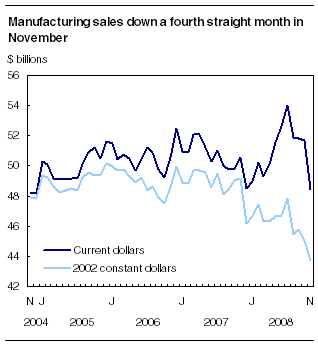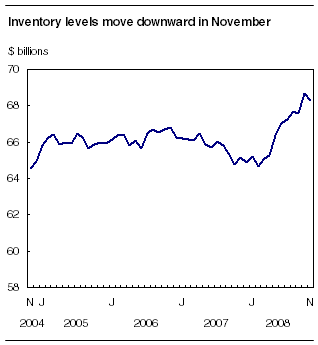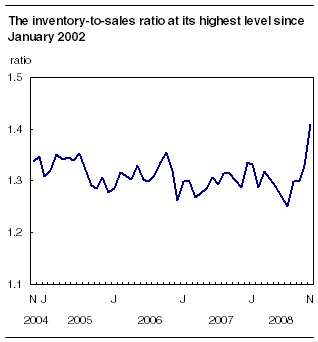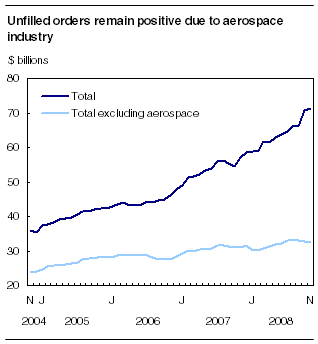Manufacturing sales in Canada decreased for a fourth consecutive month in November, Statistics Canada reported on January 20. Sales fell 6.4 percent to $48.4 billion, the lowest level since December 2004.
Constant dollar manufacturing sales, which are measured in 2002 prices, fell to their lowest level in almost 10 years, decreasing by 3.0 percent in November. Therefore, about half of the drop in the current dollar series compared with October reflected price declines. The most significant price decreases were in the petroleum and coal industry (-18.5 percent) and primary metal industry (-6.0 percent).
At the industry level, sales in 12 of 21 manufacturing industries decreased in November, accounting for over four-fifths of total sales.
Chart 1

Five largest industries in Canada report decreases
November sales were down in the five largest manufacturing industries, led by a 20.6 percent drop by petroleum and coal product manufacturers. Petroleum and coal product sales have fallen for five consecutive months. Sales have decreased by almost $3 billion compared with the peak of $8.2 billion reached in June 2008. Falling prices were the most significant factor in explaining the lower value of sales in November.
Primary metal manufacturers also reported significantly lower sales, down 17.4 percent to $4.1 billion. Sales in November were at the lowest level since March 2006, as both falling prices and deteriorating global demand negatively influenced the value of sales.
Sales in the transportation equipment industry decreased 3.9 percent in November. Aerospace products and parts production pulled back 22.5 percent, after a 27.2 percent gain in October. This was the first production decrease in the aerospace industry since August.
Note to readers
All data in this release are seasonally adjusted and are expressed in current dollars unless otherwise specified.
Preliminary estimates are provided for the current reference month. Estimates, based on late responses, are revised for the three previous months.
Non-durable goods industries include food, beverage and tobacco products, textile mills, textile product mills, clothing, leather and allied products, paper, printing and related support activities, petroleum and coal products, chemicals, and plastics and rubber products.
Durable goods industries include wood products, non-metallic mineral products, primary metals, fabricated metal products, machinery, computer and electronic products, electrical equipment, appliances and components, transportation equipment, furniture and related products and miscellaneous manufacturing.
Production-based industries
For the aerospace industry and shipbuilding industries, the value of production is used instead of sales of goods manufactured. This value is calculated by adjusting monthly sales of goods manufactured by the monthly change in inventories of goods in process and finished products manufactured.
Unfilled orders are a stock of orders that will contribute to future sales assuming that the orders are not cancelled.
New orders are those received whether sold in the current month or not. New orders are measured as the sum of sales for the current month plus the change in unfilled orders from the previous month to the current month.
In November, chemical product manufacturers posted an 8.7 percent drop in sales, which was largely due to the resin, synthetic rubber, and artificial and synthetic fibres and filaments industry.
Sales decline in all provinces
Every province reported decreased manufacturing sales in November, ranging from a 0.3 percent decline in Saskatchewan to a 31.5 percent drop in New Brunswick. In the Atlantic provinces as a whole, manufacturing sales were down 21.7 percent, reflecting a sizeable decline in petroleum product prices.
Manufacturing sales fell by 7.6 percent in Quebec, erasing the 3.6 percent rise in October. The drop in sales for November was mainly due to declines in the primary metal and aerospace manufacturing industries.
Ontario's manufacturing sales declined 3.9 percent, the fourth consecutive monthly decrease. Petroleum and coal product sales fell by 20.1 percent, reflecting the drop in petroleum prices. Primary metal manufacturing for the province declined by 16.2 percent compared with October.
The decline in Alberta's manufacturing sales steepened in November. Sales fell 8.8 percent, following a 6.2 percent drop in October. The chemical product industry (-31.7 percent) was the leading cause of decreased provincial sales. In addition, petroleum and coal products sales fell by 15.2 percent.
Sales in British Columbia decreased by 3.6 percent, primarily due to declines in the wood and paper product industries.
Table 1
| October 2008r | November 2008p | October to November 2008 | |
|---|---|---|---|
| Seasonally adjusted | |||
| $ millions | % change1 | ||
| Canada | 51,707 | 48,414 | -6.4 |
| Newfoundland and Labrador | 524 | 411 | -21.5 |
| Prince Edward Island | 113 | 106 | -6.0 |
| Nova Scotia | 912 | 845 | -7.4 |
| New Brunswick | 1,524 | 1,044 | -31.5 |
| Quebec | 13,351 | 12,334 | -7.6 |
| Ontario | 23,403 | 22,492 | -3.9 |
| Manitoba | 1,414 | 1,370 | -3.1 |
| Saskatchewan | 1,048 | 1,044 | -0.3 |
| Alberta | 6,012 | 5,484 | -8.8 |
| British Columbia | 3,400 | 3,278 | -3.6 |
| Yukon | 3 | 3 | -0.8 |
| Northwest Territories and Nunavut | 2 | 2 | -11.0 |
Petroleum and coal product inventories declined 9.8 percent, and primary metal manufacturers reported a 2.7 percent drop. Price decreases were a significant factor in the lower value of inventory in both cases. Offsetting these declines were increases of 4.6 percent in computers and electronics and 2.5 percent in aerospace products and parts.
Chart 2

The inventory-to-sales ratio increased to 1.41 in November, the highest level since January 2002. This eight-point jump was the largest month-to-month gain since June 1998, moving the ratio well above its three-year average of 1.30. The inventory-to-sales ratio is a measure of the time, in months, that would be required to exhaust inventories if sales were to remain at their current level.
Chart 3

Unfilled orders rose 0.8 percent in November for the sixth gain in seven months. Aerospace products and parts increased 2.7 percent after a 14.1 percent gain in October. Fabricated metal products partially offset this advance with a decline of 3.8 percent, the second decrease in three months. Excluding the aerospace industry, unfilled orders decreased 1.4 percent in November.
For the first time since April 2008, new orders fell below $50 billion, dropping 12.9 percent in November to $49.0 billion. The aerospace industry accounted for half of this decline, with new orders down $4.1 billion.
Chart 4

Table 2
Table 2
| Sales | Inventories | Unfilled orders | New orders | Inventory-to-sales ratio | |||||
|---|---|---|---|---|---|---|---|---|---|
| Seasonally adjusted | |||||||||
| $ millions | % change | $ millions | % change | $ millions | % change | $ millions | % change | ||
| November 2007 | 50,569 | 1.6 | 65,154 | 0.6 | 57,005 | 4.5 | 53,034 | 8.2 | 1.29 |
| December 2007 | 48,535 | -4.0 | 64,854 | -0.5 | 58,530 | 2.7 | 50,060 | -5.6 | 1.34 |
| January 2008 | 48,999 | 1.0 | 65,220 | 0.6 | 58,857 | 0.6 | 49,326 | -1.5 | 1.33 |
| February 2008 | 50,211 | 2.5 | 64,679 | -0.8 | 58,733 | -0.2 | 50,088 | 1.5 | 1.29 |
| March 2008 | 49,326 | -1.8 | 65,026 | 0.5 | 61,753 | 5.1 | 52,346 | 4.5 | 1.32 |
| April 2008 | 50,102 | 1.6 | 65,240 | 0.3 | 61,306 | -0.7 | 49,655 | -5.1 | 1.30 |
| May 2008 | 51,509 | 2.8 | 66,389 | 1.8 | 62,866 | 2.5 | 53,069 | 6.9 | 1.29 |
| June 2008 | 52,646 | 2.2 | 67,046 | 1.0 | 63,903 | 1.6 | 53,683 | 1.2 | 1.27 |
| July 2008 | 53,998 | 2.6 | 67,243 | 0.3 | 64,564 | 1.0 | 54,660 | 1.8 | 1.25 |
| August 2008 | 51,873 | -3.9 | 67,682 | 0.7 | 66,493 | 3.0 | 53,802 | -1.6 | 1.30 |
| September 2008 | 51,819 | -0.1 | 67,618 | -0.1 | 66,145 | -0.5 | 51,470 | -4.3 | 1.30 |
| October 2008 | 51,707 | -0.2 | 68,749 | 1.7 | 70,702 | 6.9 | 56,264 | 9.3 | 1.33 |
| November 2008 | 48,414 | -6.4 | 68,330 | -0.6 | 71,296 | 0.8 | 49,008 | -12.9 | 1.41 |




